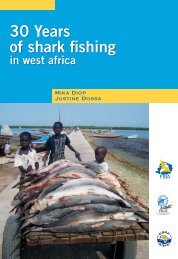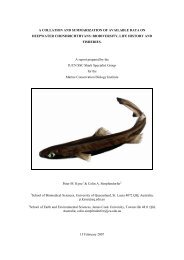Magazine of the species survival Commission specialist Group - IUCN
Magazine of the species survival Commission specialist Group - IUCN
Magazine of the species survival Commission specialist Group - IUCN
You also want an ePaper? Increase the reach of your titles
YUMPU automatically turns print PDFs into web optimized ePapers that Google loves.
fungi: <strong>the</strong> orphans <strong>of</strong> rio<br />
Cyttaria espinosae. © David Minter Zeus olympius. © David Minter<br />
in need <strong>of</strong> protection. In many countries <strong>the</strong>re is no explicit<br />
legal protection for fungi.<br />
The <strong>IUCN</strong> has recognized this problem and, in 2009,<br />
reorganized and expanded its SSC groups which include<br />
fungi. Where <strong>the</strong>re were previously two groups <strong>the</strong>re are now<br />
five, and where fungal SSC groups were formerly listed under<br />
‘plants’, <strong>the</strong>y are now correctly grouped in <strong>the</strong>ir own<br />
independent category. David Minter, a <strong>specialist</strong> in<br />
ascomycetes, a huge group which includes truffles and<br />
morels, is a Chair <strong>of</strong> one <strong>of</strong> <strong>the</strong>se groups. Collectively, <strong>the</strong>y<br />
have <strong>the</strong> daunting task <strong>of</strong> building an infrastructure for fungal<br />
conservation and raising awareness at all levels <strong>of</strong> <strong>the</strong> need<br />
to protect fungi.<br />
When David Minter came out <strong>of</strong> university, he was<br />
employed in an institution devoted to fungi with a job<br />
identifying global microscopic <strong>species</strong>. David describes his<br />
work as, “a privilege to see <strong>the</strong> wonderful diversity <strong>of</strong> <strong>the</strong>se<br />
organisms and, with <strong>the</strong> constant arrival <strong>of</strong> specimens<br />
representing new <strong>species</strong>, my colleagues and I became<br />
increasingly aware that <strong>the</strong> fungi already known and<br />
described form only a tiny proportion <strong>of</strong> what is probably out<br />
<strong>the</strong>re”. Now, <strong>the</strong> generally accepted estimate is that easily<br />
over 90% <strong>of</strong> all <strong>the</strong> planet’s fungal <strong>species</strong> still await<br />
discovery. Over <strong>the</strong> same period, a consistent and long-term<br />
failure at governmental level to support basic taxonomic<br />
research has meant that David’s colleagues were not<br />
replaced when <strong>the</strong>y left and, by 1999, <strong>the</strong> institution itself had<br />
ceased to exist. These are not easy conditions in which to<br />
promote fungal conservation.<br />
The fungal Specialist <strong>Group</strong>s <strong>of</strong> <strong>the</strong> <strong>IUCN</strong> SSC need to<br />
get <strong>the</strong>ir message across to <strong>the</strong> public and <strong>the</strong>ir governments<br />
worldwide. It is particularly important to get fungi better<br />
recognized by <strong>the</strong> Convention on Biological Diversity (CBD).<br />
When it was created in Rio, in 1992, <strong>the</strong> CBD established <strong>the</strong><br />
right to protect all forms <strong>of</strong> life, and “all forms <strong>of</strong> life” includes<br />
fungi. Unfortunately, its text classified biodiversity as<br />
“animals, plants and micro-organisms”, i.e. two taxonomic<br />
kingdoms and a third category defined by size. Fungi belong<br />
in nei<strong>the</strong>r <strong>the</strong> animal nor plant kingdom, however, <strong>the</strong>y do<br />
include in <strong>the</strong>ir number some <strong>of</strong> <strong>the</strong> largest single living<br />
individuals known on earth. One genetically uniform colony <strong>of</strong><br />
<strong>the</strong> toadstool Amanita ostyae, in <strong>the</strong> Malheur National Forest<br />
<strong>of</strong> Oregon, covers an area <strong>of</strong> almost 9 km 2 , making it far<br />
bigger than <strong>the</strong> Blue Whale or any <strong>of</strong> <strong>the</strong> great redwoods.<br />
The term micro-organism – that third category – <strong>the</strong>refore<br />
hardly seems appropriate.<br />
Fungi simply do not fit <strong>the</strong>se inadequate CBD definitions,<br />
and are suffering as a result. Their right to protection has been<br />
established, but <strong>the</strong> Convention has provided no machinery<br />
for ensuring it happens. Many national biodiversity action<br />
plans produced in response to <strong>the</strong> Convention fail to consider<br />
fungi at all. The few which do usually treat <strong>the</strong>m as ‘lower<br />
plants’ – an obscure corner <strong>of</strong> botany. The CBD designated<br />
2010 as <strong>the</strong> ‘International Year <strong>of</strong> Biodiversity’, but <strong>the</strong><br />
accompanying logo shows only animals and plants, and fungi<br />
are not mentioned in <strong>the</strong> <strong>of</strong>ficial video made to promote <strong>the</strong><br />
year (www.youtube.com/watch?v=V1VYmpTikgw). This is a<br />
compelling and very public indication that, as presently<br />
organized, <strong>the</strong> CBD is not delivering protection for <strong>the</strong>se<br />
critically important organisms. As David Hawksworth, one <strong>of</strong><br />
<strong>the</strong> world’s leading fungal experts, so eloquently stated, fungi<br />
are truly “<strong>the</strong> orphans <strong>of</strong> Rio”.<br />
The rapidly declining resources available for work with<br />
fungal biodiversity made it clear that to conserve fungi, <strong>the</strong><br />
first step was to conserve mycologists – <strong>the</strong> scientists who<br />
work with <strong>the</strong>se organisms. The second step was to digitize<br />
existing information about when and where fungi occur, to<br />
provide an objective basis for future work. Outside <strong>the</strong><br />
developed world, <strong>the</strong>re are very few countries where<br />
mycologists can be found. Over 16 years, with funding from<br />
<strong>the</strong> UK Darwin Initiative, David ran projects which delivered<br />
support to those mycologists, while at <strong>the</strong> same time<br />
digitizing vast numbers <strong>of</strong> fungal records. The results <strong>of</strong> that<br />
work are now available through <strong>the</strong> Cybertruffle website<br />
(www.cybertruffle.org.uk). Information about when and where<br />
fungi occur (www.cybertruffle.org.uk/robigalia) is delivered in<br />
10 different languages. In ano<strong>the</strong>r initiative to alleviate <strong>the</strong><br />
information impediment outside <strong>the</strong> developed world, <strong>the</strong>re is<br />
6 • <strong>species</strong> 52
















